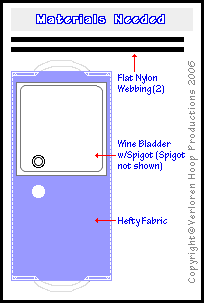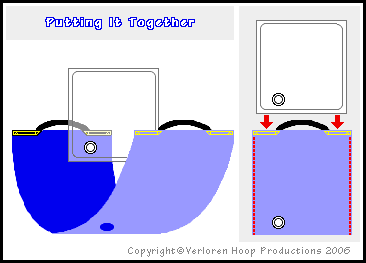The Practical Paddler: Part 6
The world is divided into two great tribes: Tossers and Hoarders. (Brits won't have any trouble guessing where my allegiance lies.) Tossers boast that they keep nothing they don't have an immediate use for. Hoarders, on the other hand, keep everything — or almost everything. Our garages, basements, attics, and spare rooms, not to mention our garden sheds, fill up with stuff we simply can't bring ourselves to throw away: broken furniture, old clothes, even plastic bottles. The explanation is simple. Hoarders, like archeologists, find treasure where others see only trash. Some might think the resulting clutter unsightly, I suppose, but we Hoarders pride ourselves on looking beneath the surface of things. Why throw something away today when it might be useful tomorrow? And why spend money for something new when you can recycle or reuse something old?
Tossers don't understand this line of argument, of course. They shudder in horror when they look at the stacks of rusting coffee cans, the ripped tarp, the bike with no wheels, the wheels that fit no bike, the broken paddle, and the collection of torn rubber wellies. Tossers call all this stuff "junk." But we Hoarders know better, don't we? Like thrifty chipmunks, who store far more nuts than they can eat, just in case an unscheduled Ice Age catches them napping, Hoarders are always putting a little something aside for the future.
This pays unexpected dividends. We while away many happy hours sorting and rearranging our hoards, reacquainting ourselves with our booty again and again. What better way to spend a snowbound Sunday afternoon? Admittedly, the return on our investment of time is… well…let's say it's variable, shall we? But occasionally we find gold among the dross. Sometimes it's as easy — or as hard — as seeing a new use for a seemingly worthless bit of jetsam. One In the Same Boat reader, Art Denney, reflecting on the proliferation of giveaway CDs, had the brilliant idea of recycling them as signal and shaving mirrors. At other times, however, the transformation from trash to treasure is a trifle less straightforward. Take two items pulled from my own hoard, for example: a heavy-duty plastic bladder that once held five liters of California's best ten-dollar plonk, and the only surviving panel from the nylon tarp that a mountain microburst blew to buggery. The plastic bladder is sturdy. The fabric panel is still sound. Surely, I think, I can make something useful from them. But my imagination refuses to rise to the challenge. I then retreat to a hot bath to wash the dust from my body — we Hoarders are often indifferent housekeepers — and to ponder deeply on The Meaning of It All.
Suddenly, inspiration strikes. I'll make a water bag. It's a real-life Eureka! moment. Of course, a bathtub is a good place to contemplate the importance of water. We paddlers are aquatic animals. Water floats our boats and buoys our spirits. And its utility doesn't stop there. Paddling is thirsty work, and, as Jerome K. Jerome reminded readers of Three Men in a Boat, "thirst is a dangerous thing." If we ignore its early warnings our internal thermostat goes haywire and our muscles grow weak. But the water on which we travel is seldom safe to drink. It's one of our sport's crueler ironies: even on freshwater lakes, paddlers have to carry water along with them. And you can't carry water in your hands, can you? Not while wielding a paddle, at any rate — and certainly not on the portage trail. So some sort of water bag is desirable, even on the shortest trip. After all, water is easier to disinfect in bulk. Water bags have other uses, too. It takes a lot more than a canteen cup's worth of water to do the dishes and clean our bodies at the end of a long day. A water bag is the answer. It holds more than any canteen, yet it can be rolled up and stowed away in a pack pocket when empty. And it's versatile. Under way, a full water bag can be lashed atop the packs in your canoe, or on the stern deck of your kayak. (It pays to be mindful of the added weight, however. Water is heavy, and putting too much too high will make your boat unstable. Then again, a filled water bag makes a good trimming weight in a sailing canoe.) Once off the water and on the trail, lash your water bag to a packframe. And later, in camp, hang it from a tree limb on a lanyard.
Where is all this leading? A water bag is a very useful piece of gear. Every paddler should have one (or two). And what is a water bag but a bladder cradled in a fabric cover? OK. I have the bladder. I also have a piece of fabric. I'm almost there. Guided by the light of inspiration, I get to work. Here's my final…
Bill of Materials
It's not very long. It includes these items:
- Five-liter plastic wine bladder (with spigot)
- Sturdy fabric, large enough to go right around the bladder, with a little more to spare
- Some nylon webbing
- Strong thread
A sewing machine that can cope with webbing makes the assembly job easier, of course, but if you don't have one a sailor's palm or Speedy Stitcher® will do a fine job. Even a heavy-duty needle and thimble will work — if you take your time. Now let's lay out our materials and have a look at them…

Because wine bladders vary in size and shape, this sketch isn't drawn to scale. I'm sure you get the idea, however. The lines of stitching are shown in white, and the locations of the webbing handles are outlined in gray. Note that the webbing must be longer then the width of the bag to allow loops to be formed. Now it's time to…
Get It Together
Cut the fabric to size, making sure that the finished cover will accommodate the bulging belly of a full bladder. Allow extra material for the side seams and for attaching the webbing handles, too. Now stitch the sides to make an envelope — overturning the seams for a more finished appearance, if you want — and attach the webbing. (Warning! Unfinished cut edges of nylon fabric and cut ends of nylon webbing will quickly fray and unravel unless they're heated to the melting point. A butane lighter will do the job, as will a hot knife. Work in a well-ventilated room, though, and mind your fingers. Molten nylon can cause a nasty burn.) A reminder: Don't sew the bladder into the cover. Leave an opening at the top, instead, and insert the bladder after you've finished the stitching. You'll need to remove the bladder for cleaning from time to time. Lastly, once you're satisfied with your handiwork, cut a hole in the cover fabric for the spigot. That's it. You've done the hard work.
Get the picture? If not, this may help…

On the left, an overview of the assembly process. On the right, an illustration of the final step — slipping the bladder into place. (You'll have to fold the corners of the bladder over in order to snake it through the gap you left at the top of the cover, of course.) Here, the stitching at the sides is highlighted in red, while that anchoring the webbing handles is yellow. When the bladder is in position, with its nozzle protruding through the hole that you cut earlier, fit the spigot. Congratulations. You've just acquired a new water bag. Simple, wasn't it? One caution, however: Whoever said "Measure twice and cut once" knew what he was about. It's easy to trace a new line on a piece of fabric, but after you've made the first cut, there's no turning back. A careful trial can prevent a lot of errors.
Filling the water bag will require that you remove the spigot. Some spigots are easier to get off than others. If yours is one of the hard cases, you'll find that the little metal key you got when you bought your last gallon of house paint works like a charm to force the issue. (I discovered one of these in my hoard, along with all the webbing I needed for two handles. There really is treasure in the trash.) Once the bag is full — don't try to hold it in your hands while you're filling it! — replace the spigot, add the proper number of water purification tablets, and shake. Soon (just how soon will depend on the water temperature, among other things), you'll be able to take a drink, though if you're concerned about parasitic cysts, you'll need to filter the water, as well. In this case, you'll probably want a second bag.
Feeling grubby after all your exertions? Then you'll find another use for your new bag. It's also good for…
Cleaning Up
When is a water bag more than a water bag? When you've fitted it with a shower head, of course. You can get ready-made shower adapters from outfitters like Campmor, or you can make your own. All it takes is a length of aquarium tubing, a spring clamp of some sort, and the nozzle from an old plastic watering can. This won't be any problem for a veteran Hoarder. Then, when the urge for a hot shower strikes in the backcountry, all you have to do is heat some water, temper it with cold to bring it down to a comfortable temperature (if necessary), and fill the bladder. Now hang the bag from a convenient limb — to avoid contaminating surface waters with soap, locate your improvised shower well away from river or lake — and get your washcloth.
Easy? You bet. But if you've never used a shower bag before, try it out in your bathroom at home first. In fact, even if you never intend to use your water bag for anything other than hauling water, it's a good idea to give it a dry…er…wet run in the backyard before taking it into the bush. That's just common sense, isn't it?
Tossers and Hoarders will never see eye to eye. But we Hoarders know we're right. The only thing needed to convert trash into treasure is a little imagination. We supply the imagination. Our hoards supply the trash. The result? Something for nothing — or near enough, anyway. And our new water bag is proof of that.
Copyright © 2006 by Verloren Hoop Productions. All rights reserved
Related Articles
In this video, Chad Hoover shows you how to flip your fishing kayak upright and do a deep water…
Creekboating is as much a game of strategy as it is a sport. Half of your time on creeks is spent…
I always tell my students "when nature calls, answer!" If you are in your kayak and out on the water how…
Sailing a canoe, the act of being propelled across a large lake or wide river, can be absolutely…


